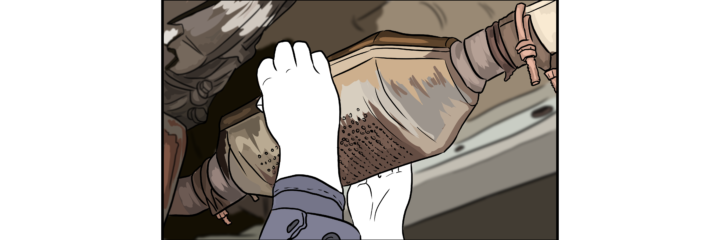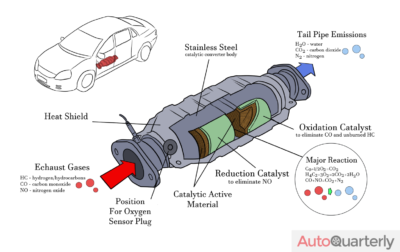There are some clear signs that your catalytic converter is failing. Your fuel economy plummets, your car stalls while it’s idling, or you notice a rotten egg smell from your exhaust. Then he evidence is clear: it’s time to replace your catalytic converter. Now you’re thinking about the cost.
Repairing it by yourself is not easy. In almost every case, you’ll need to take your car to a mechanic to have your catalytic converter replaced. How do you find a trustworthy repair shop? How do you know the mechanic you hire is charging a fair price?
This guide will help you to set your expectations in terms of replacement costs. You’ll also get a basic primer on the role of your catalytic converter, and an idea of the work it takes to replace it.
Catalytic Converter Replacement: Parts Cost
You have some choices here. First, you can purchase a vehicle-specific catalytic converter. You can also choose a universal one.
The part you buy should meet EPA standards. There are also CARB compliant catalytic. These are made specifically to comply with higher emissions standards in California.
A basic, universal converter can cost less than 100 dollars. A high-performance component that is CARB compliant for a high-end vehicle could be more than $3,000. Therefore, a major variant in the cost is the type of car you drive.
If you are replacing the converter yourself, there are other parts you are also likely to need. These include:
- Catalytic Converter Gasket
- Air Tube
- Oxygen Sensor Wrench
Finally, consider that this is a good time to fix or replace any failing parts that led to this issue in the first place. Take a close look at your filters, head gasket, plugs, and wires and see if work can be done simultaneously.
Catalytic Converter Replacement: Labor Cost
When it comes to labor costs, you’re looking at $70 to 130 dollars per hour. You might be able to find a small shop that will do the work for $50.
How many hours does it take to replace a catalytic converter? That depends! If everything goes smoothly, it could take about an hour. This is more likely when you’ve selected a direct fit converter, and none of your bolts have seized.
Things could take significantly longer if your catalytic converter is welded into place, or the mechanic must soak your bolts in penetrating oil to loosen them. Be warned that the shop may have to modify their time estimate, based on what they discover beneath your vehicle. It’s reasonable to expect to pay $300 or more for labor costs, depending on the size of the job.
Therefore, expect to pay between $1000 and $2500 for most catalytic converter replacements depending on your car. That’s quite a lot, so you might want to look at replacing it yourself. This is a tough job, but we’ll cover it in our guide below. First, we have a basic guide to catalytic converters.
What Does a Catalytic Converter Do?
If you could dissect one, you wouldn’t find any moving parts. It’s a long, semi-cylindrical component filled with a ceramic, honeycomb material. That material is coated with catalyst particles. Your vehicle exhaust flows through this honeycomb before leaving your car. The heavily polluted exhaust is heated, and reacts with the catalyst particles. That reaction cleans your exhaust fumes, and reduces emissions significantly.
What Causes It to Fail?
Catalytic converters are a pretty inert piece of equipment. When one fails, something else is usually wrong as well. If you don’t fix the underlying cause, your new converter could fail as well. It may cost more to fix things properly, but the repair will last longer.
Here are some underlying causes to consider:
- Faulty plugs and plug wires
- Fuel entering the exhaust system
- Impacts due to potholes and other road conditions
- Failing to get regular tune ups
- Antifreeze or oil in the exhaust
- Bad O2 sensor
- Frequent short trips causing the catalytic converter to clog
Can I Put off Replacing My Catalytic Converter?
Your catalytic converter is an important piece of equipment. You need this part to function to be sure your car continues to run properly. In addition to this, catalytic converters clean up your exhaust, and reduce pollutants.
This doesn’t mean you have to rush out, and pay for a full replacement immediately. You may have a bit of time, but keep the following in mind:
- Your car may fail an emissions test
- The engine in your car could stall or misfire.
- Your fuel economy will drop.
- Acceleration may become weak and jerky.
Over time, you’ll notice these problems becoming worse. Eventually, your car could become undriveable. A planned replacement could be better than an emergency repair.
Is Repair an Option?
Unfortunately, there is no way to disassemble a catalytic converter to repair its components. When it’s time, you’ll have to replace the entire thing.
On a positive note, there are things you can do to alleviate minor issues, and get a bit more life out of yours. Consider trying the following:
Cleaning Your Catalytic Converter
Remove your catalytic converter, and use a pressure washer to blow out any contaminants. Do this from both ends of the part.
Another option is to soak it overnight in a mixture of hot water and degreaser. You can also use laundry detergent. This takes longer, but is quite effective. Just be sure everything is completely dry before you reinstall it.
Drive at Higher Speeds
Take at least one trip per week that involves driving at highway speeds for at least 20 minutes. This will help clear out debris that can clog your converter. Consider driving your car harder than normal. Do this by engaging in hard accelerations, multiple times, for a mile or two.
Use The Right Fuel
Be certain to use the right fuel for your vehicle. Fill up only at reputable service stations. Finally, don’t allow your fuel to go too low. Otherwise, sediment from your gas tank could be kicked up into your fuel system.
Try a Fuel Additive
Use a fuel cleaning additive to clean out your car’s system. Stick with well-known brands that have been around for a while. Don’t risk damaging your engine with an off-brand, budget product.
Testing Your Catalytic Converter
If you have an older car, you can use a simple mallet test to see if your converter needs to be replaced. Simply strike it firmly with a mallet. If you hear rattling, your unit has begun to come apart inside. In that case, it definitely needs to be replaced.
Of course, no rattling doesn’t mean your unit is fine. Your catalytic converter could still be underperforming. Consider replacing it if high performance and fuel efficiency are high priorities for you.
You can also conduct a back pressure test. Simply place a pressure gauge in the hole on the O2 sensor. The pressure should be under 1.25 when your engine is running at 20K RPMs.
Can You Replace Your Own Catalytic Converter?
It’s possible, but it will take some skill and some tools. You’ll need access to a lift or four jack stands. Make sure you have a flat surface that’s safe for working. Don’t forget the special wrench for your O2 sensor. Fortunately, many car parts stores have those available for lending.
Now, for some bad news. If your converter has been welded into place, you’ll need a Sawzall to take it off. Then, you’ll need a welder to attach the new part. Take all of this into consideration before you get elbow deep into this project.
The Process of Changing a Catalytic Converter

You’ll take different steps depending on the year, make, and model of your car. Still, the following article will give you a basic idea of the procedure for changing your catalytic converter
Here’s our summary:
- Find a safe and level surface.
- Jack up your vehicle and place it on four jack stands.
- Crawl underneath your car and locate the catalytic converter.
- Note how your converter is seated and how it is attached.
If It’s Welded
Remove the O2 sensor and secure a Sawzall and a welder. Use your saw to cut along the previous welding lines. Install universal or direct-fit catalytic converters according to the instructions provided in the packaging. You’ll need a professional machine, so If you aren’t a competent welder with the right equipment, you’ll need to hire out this job. Once the unit is in place, and all welds have cooled, replace the oxygen sensor.
If It’s Bolted
For bolted units, remove the back bolts first, then the front. Support the unit as you remove the bolts. Secure socket wrenches and penetrating oil. Use the penetrating oil if the bolts won’t turn.
Then install the converter according to the model’s instructions. Be sure to replace any bolts and gaskets correctly.
Check your work over to verify that everything is done correctly. Try moving a lit candle along your exhaust pipes while your engine is running. If there are leaks, the air pressure should blow the candle out or make it flicker.
What to Expect After Catalytic Converter Replacement
No matter how you get the work done, you’ll notice a positive change almost immediately. Your car will run better and become more fuel-efficient, as well as producing less pollution overall. Enjoy a safer, cleaner ride with your new catalytic converter.



